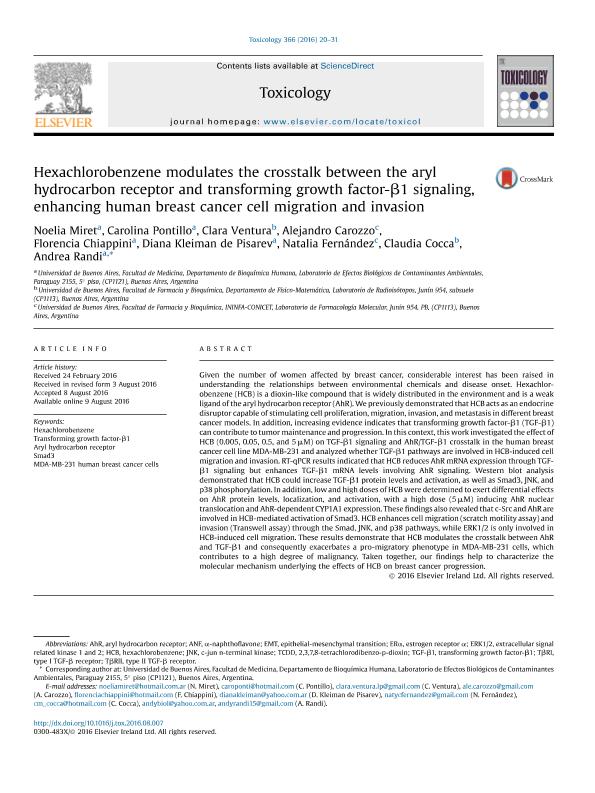Artículo
Hexachlorobenzene modulates the crosstalk between the aryl hydrocarbon receptor and transforming growth factor-β1 signaling, enhancing human breast cancer cell migration and invasion
Miret, Noelia Victoria ; Pontillo, Carolina Andrea
; Pontillo, Carolina Andrea ; Ventura, Clara
; Ventura, Clara ; Carozzo, Alejandro Enrique
; Carozzo, Alejandro Enrique ; Chiappini, Florencia Ana
; Chiappini, Florencia Ana ; Kleiman, Diana Leonor
; Kleiman, Diana Leonor ; Fernandez, Natalia Cristina
; Fernandez, Natalia Cristina ; Cocca, Claudia Marcela
; Cocca, Claudia Marcela ; Randi, Andrea Silvana
; Randi, Andrea Silvana
 ; Pontillo, Carolina Andrea
; Pontillo, Carolina Andrea ; Ventura, Clara
; Ventura, Clara ; Carozzo, Alejandro Enrique
; Carozzo, Alejandro Enrique ; Chiappini, Florencia Ana
; Chiappini, Florencia Ana ; Kleiman, Diana Leonor
; Kleiman, Diana Leonor ; Fernandez, Natalia Cristina
; Fernandez, Natalia Cristina ; Cocca, Claudia Marcela
; Cocca, Claudia Marcela ; Randi, Andrea Silvana
; Randi, Andrea Silvana
Fecha de publicación:
07/2016
Editorial:
Elsevier Ireland
Revista:
Toxicology
ISSN:
0300-483X
Idioma:
Inglés
Tipo de recurso:
Artículo publicado
Clasificación temática:
Resumen
Given the number of women affected by breast cancer, considerable interest has been raised in understanding the relationships between environmental chemicals and disease onset. Hexachlorobenzene (HCB) is a dioxin-like compound that is widely distributed in the environment and is a weak ligand of the aryl hydrocarbon receptor (AhR). We previously demonstrated that HCB acts as an endocrine disruptor capable of stimulating cell proliferation, migration, invasion, and metastasis in different breast cancer models. In addition, increasing evidence indicates that transforming growth factor-β1 (TGF-β1) can contribute to tumor maintenance and progression. In this context, this work investigated the effect of HCB (0.005, 0.05, 0.5, and 5 μM) on TGF-β1 signaling and AhR/TGF-β1 crosstalk in the human breast cancer cell line MDA-MB-231 and analyzed whether TGF-β1 pathways are involved in HCB-induced cell migration and invasion. RT-qPCR results indicated that HCB reduces AhR mRNA expression through TGF-β1 signaling but enhances TGF-β1 mRNA levels involving AhR signaling. Western blot analysis demonstrated that HCB could increase TGF-β1 protein levels and activation, as well as Smad3, JNK, and p38 phosphorylation. In addition, low and high doses of HCB were determined to exert differential effects on AhR protein levels, localization, and activation, with a high dose (5 μM) inducing AhR nuclear translocation and AhR-dependent CYP1A1 expression. These findings also revealed that c-Src and AhR are involved in HCB-mediated activation of Smad3. HCB enhances cell migration (scratch motility assay) and invasion (Transwell assay) through the Smad, JNK, and p38 pathways, while ERK1/2 is only involved in HCB-induced cell migration. These results demonstrate that HCB modulates the crosstalk between AhR and TGF-β1 and consequently exacerbates a pro-migratory phenotype in MDA-MB-231 cells, which contributes to a high degree of malignancy. Taken together, our findings help to characterize the molecular mechanism underlying the effects of HCB on breast cancer progression.
Archivos asociados
Licencia
Identificadores
Colecciones
Articulos(IQUIFIB)
Articulos de INST.DE QUIMICA Y FISICO-QUIMICA BIOLOGICAS "PROF. ALEJANDRO C. PALADINI"
Articulos de INST.DE QUIMICA Y FISICO-QUIMICA BIOLOGICAS "PROF. ALEJANDRO C. PALADINI"
Articulos(OCA HOUSSAY)
Articulos de OFICINA DE COORDINACION ADMINISTRATIVA HOUSSAY
Articulos de OFICINA DE COORDINACION ADMINISTRATIVA HOUSSAY
Citación
Miret, Noelia Victoria; Pontillo, Carolina Andrea; Ventura, Clara; Carozzo, Alejandro Enrique; Chiappini, Florencia Ana; et al.; Hexachlorobenzene modulates the crosstalk between the aryl hydrocarbon receptor and transforming growth factor-β1 signaling, enhancing human breast cancer cell migration and invasion; Elsevier Ireland; Toxicology; 366-367; 7-2016; 20-31
Compartir
Altmétricas



